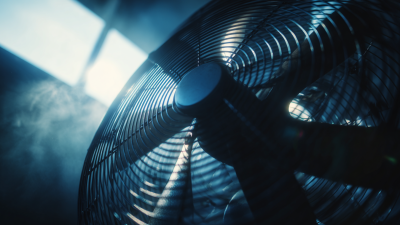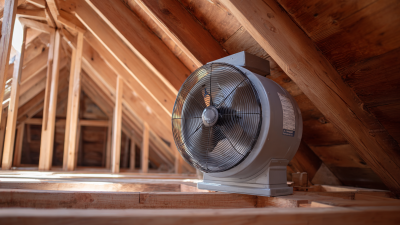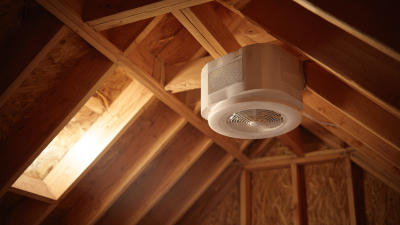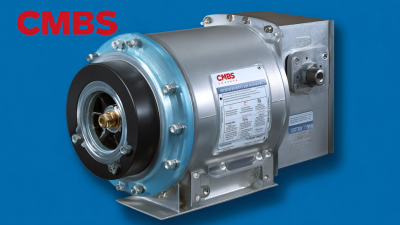




Proper ventilation is essential for maintaining a comfortable living environment, and one of the most effective ways to achieve this is through the use of attic fan motors. According to the U.S. Department of Energy, proper airflow can reduce cooling costs by up to 30% during the warmer months, making it crucial for homeowners to invest in high-quality attic fan motors. These motors play a pivotal role in promoting optimal air circulation, preventing heat buildup, and reducing humidity levels in attics and living spaces. With the right attic fan motor, not only can you enhance your home’s energy efficiency, but you can also prolong the lifespan of your roof and insulation. In this article, we will explore the five best attic fan motors that guarantee optimal air circulation, ensuring that your home remains cool, comfortable, and energy-efficient year-round.

When selecting attic fan motors for optimal air circulation, it's crucial to consider a few key features that contribute to home efficiency. According to the Department of Energy, proper ventilation can reduce cooling costs by up to 30%. Thus, choosing a motor that operates quietly while delivering maximum airflow is essential. Look for motors with variable speed options that allow you to adjust the airflow based on the temperature and humidity levels in your attic, ensuring energy-efficient operation during different seasons.
Another important factor to examine is the energy efficiency rating of the attic fan motor. Motors with a high Energy Star rating consume less electricity, significantly impacting your energy bills over time. Additionally, opting for DC motors can offer substantial energy savings compared to traditional AC motors, as they are known to use up to 70% less energy.
**Tip:** Regular maintenance of your attic fan motor, such as cleaning the blades and lubricating the bearings, can enhance its efficiency and prolong its lifespan. Also, consider models with built-in thermostats to automate operation based on attic temperature, further optimizing energy usage without manual adjustments.
When it comes to enhancing air circulation in your home, understanding the different types of attic fan motors is crucial. The primary types of motors found in attic fans are belt-driven and direct drive motors. Belt-driven motors are typically more robust and offer improved efficiency, particularly for larger spaces. Direct drive motors, on the other hand, provide less maintenance and quieter operation, making them ideal for residential applications where noise reduction is paramount. According to industry reports, a well-optimized attic fan can reduce indoor temperatures by as much as 10-15 degrees Fahrenheit, which is significant during the peak summer months.
Moreover, advancements in motor technology have improved energy efficiency, resulting in lower utility costs for homeowners. Modern attic fans equipped with variable speed motors allow for tailored ventilation according to the specific needs of the home, maximizing cooling potential while minimizing energy consumption. However, it's important to note recent recalls regarding certain electric motors due to fire hazards, which highlights the necessity of investing in reliable and tested products. Understanding your options enables homeowners to make informed decisions on which attic fan motor best suits their air circulation and cooling needs.
When selecting the right size attic fan for your home, it's crucial to consider your attic's square footage and the desired airflow rate. A general rule of thumb is to aim for a ventilation rate of 1 cubic foot per minute (CFM) for every square foot of attic space. Therefore, if your attic is 1,500 square feet, you should look for a fan that can provide around 1,500 CFM. Additionally, be mindful of your local climate, as areas with hotter temperatures may require a more powerful fan to ensure optimal air circulation.
**Tips:** Always measure your attic space accurately before purchasing a fan. Consider using a fan with adjustable speed settings, as this allows you to tailor air circulation according to the season or time of day. Moreover, look for models equipped with thermostats that automatically turn on and off based on the temperature, ensuring energy efficiency and maintaining a comfortable attic environment.
Another important aspect is the fan’s installation and placement. Ideally, the fan should be installed at the highest point of the attic for maximum effectiveness. Properly positioning the fan helps to draw hot air out of the space, particularly during those steamy summer months, preventing heat buildup and reducing stress on your home’s cooling system.

To extend the life of your attic fan motor, regular maintenance is essential. A proactive approach, similar to the AI-driven predictive maintenance currently revolutionizing industrial operations, can significantly enhance the longevity of your equipment. Statistics show that such maintenance strategies can boost factory uptime by 15%, an inspiring figure that homeowners can also aim to achieve with their attic fans. Regular inspections, checking electrical connections, and cleaning the fan blades can help prevent unexpected failures.
Homeowners often overlook vital maintenance tasks that can keep systems like attic fans functioning efficiently. Simple measures, such as lubricating moving parts and ensuring vents are clear, can greatly impact performance. Furthermore, research indicates that addressing maintenance needs promptly not only saves on potential repair costs but also leads to better energy savings, reducing overall household expenses. Adopting these straightforward maintenance habits can protect your investment, ensuring adequate air circulation and comfort in your home for many years.

When selecting an attic fan, energy efficiency is a critical factor that can significantly impact your home's cooling costs and overall comfort. Popular attic fan models often come with varied energy efficiency ratings, which are typically denoted by the Energy Star certification and the fan's wattage consumption. Shoppers should compare these ratings to determine which models will provide the best airflow with the least energy expenditure, ultimately leading to long-term savings on electricity bills.
Additionally, the efficiency of attic fan motors is largely influenced by their design and materials. Look for fans with high-quality, durable motors that can operate quietly while effectively circulating air. Some models also feature variable speed settings, allowing homeowners to adjust the airflow based on the external temperature, maximizing efficiency. By understanding the energy efficiency ratings and features of different attic fan motors, consumers can make informed decisions that enhance their home's air circulation while minimizing energy waste.
| Model | Power (Watts) | CFM Rating | Energy Efficiency Rating (EER) | Noise Level (dB) |
|---|---|---|---|---|
| Model A | 120W | 1400 CFM | 11.67 | 50 dB |
| Model B | 100W | 1200 CFM | 12.00 | 55 dB |
| Model C | 150W | 1800 CFM | 12.00 | 52 dB |
| Model D | 90W | 1000 CFM | 11.11 | 54 dB |
| Model E | 130W | 1600 CFM | 12.31 | 48 dB |








